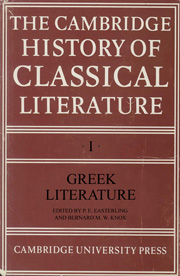Book contents
- Frontmatter
- 1 Books and readers in the Greek world
- 2 Homer
- 3 Hesiod
- 4 The epic tradition after Homer and Hesiod
- 5 Elegy and iambus
- 6 Archaic choral lyric
- 7 Monody
- 8 Choral lyric in the fifth century
- 9 Early Greek philosophy
- 10 Tragedy
- 11 The satyr play
- 12 Comedy
- 13 Historiography
- 14 Sophists and physicians of the Greek enlightenment
- 15 Plato and the Socratic work of Xenophon
- 16 Oratory
- 17 Aristotle
- 18 Hellenistic poetry
- 19 Post-Aristotelian philosophy
- 20 The literature of the Empire
- 21 Epilogue
- Appendix of authors and works
- Metrical appendix
- Works Cited in the Text
- References
8 - Choral lyric in the fifth century
Published online by Cambridge University Press: 28 March 2008
- Frontmatter
- 1 Books and readers in the Greek world
- 2 Homer
- 3 Hesiod
- 4 The epic tradition after Homer and Hesiod
- 5 Elegy and iambus
- 6 Archaic choral lyric
- 7 Monody
- 8 Choral lyric in the fifth century
- 9 Early Greek philosophy
- 10 Tragedy
- 11 The satyr play
- 12 Comedy
- 13 Historiography
- 14 Sophists and physicians of the Greek enlightenment
- 15 Plato and the Socratic work of Xenophon
- 16 Oratory
- 17 Aristotle
- 18 Hellenistic poetry
- 19 Post-Aristotelian philosophy
- 20 The literature of the Empire
- 21 Epilogue
- Appendix of authors and works
- Metrical appendix
- Works Cited in the Text
- References
Summary
INTRODUCTION
The development of monodic lyric in the sixth century toward greater variety, expressiveness and flexibility in poets like Sappho, Alcaeus, Ibycus and Anacreon cannot be documented for choral lyric. Whether because of historical accident, the popularity of monody, or an actual decline in the genre, very little choral poetry is preserved between Stesichorus and Simonides. We have a few lines of Lasus of Hermione (702–6 PMG), who is said to have introduced dithyrambic competitions into Athens under Pisistratus and competed against Simonides (cf. Aristophanes, Wasps 1410f.). He also wrote an asigmatic poem, Centaurs (704 PMG), and a poem on the death of the children of Niobe (706 PMG). A paean by one Tynnichus of Chalcis, perhaps in the sixth century, won the admiration of both Aeschylus and Plato (Ion 534d, 707 PMG), but only a small phrase survives.
Certainly the religious and social occasions for choral poetry did not diminish. On the contrary, musical performances and competitions continued to hold an important place in the cultural life of sixth- and fifth-century Greece, both at public festivals, whether local or Panhellenic, and at the courts and houses of individual tyrants and nobles, an important source of patronage for travelling poets. Hymns, paeans, dithyrambs and partheneia continued to be performed at religious celebrations, while enkomia, dirges, marriage-songs and victoryodes were commissioned by rulers or nobles for private festivities. Many of these latter, as we shall see in the case of Pindar, would be public in nature, a display of munificence affirming the donor's high standing in the community.
- Type
- Chapter
- Information
- The Cambridge History of Classical Literature , pp. 222 - 244Publisher: Cambridge University PressPrint publication year: 1985
References
- 3
- Cited by

